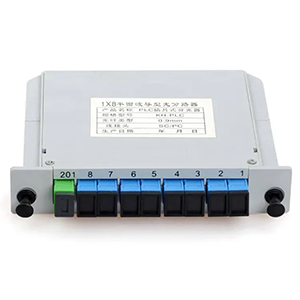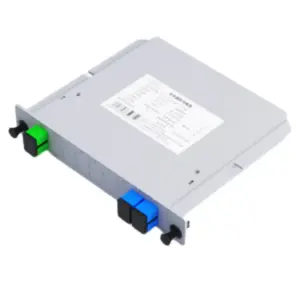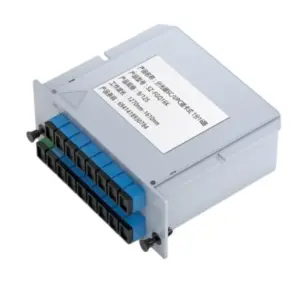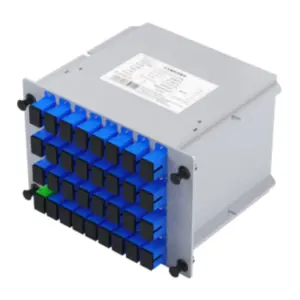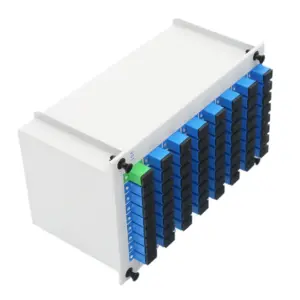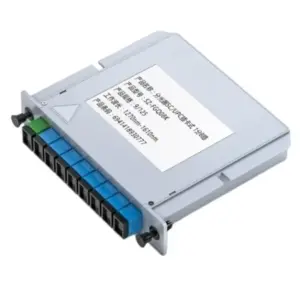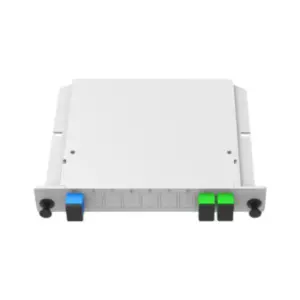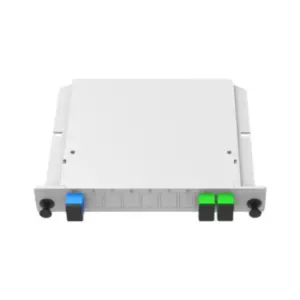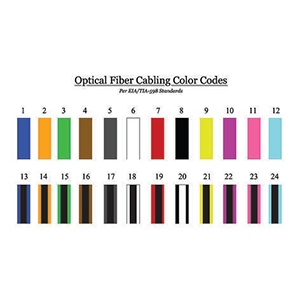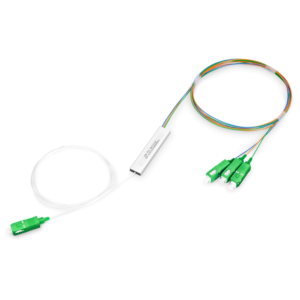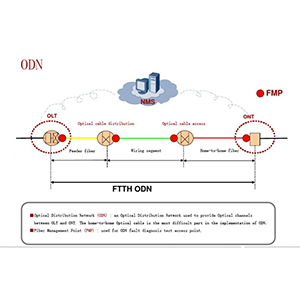In this article, I will delve into the definition, functions, and application areas of optical splitters. We will introduce the importance and role of optical splitters in fiber optic networks and their key functions in distributing and combining optical signals. As a key device, optical splitters play an important role in optical fiber communications, optical sensing and optical networks. Let us explore the wonderful applications of optical splitters in the world of optical fiber networks!
What is an optical splitter
An optical splitter is an optical device widely used in optical fiber networks to distribute and combine optical signals. Its basic definition and function are as follows:
-
Basic definition and function:
An optical splitter is an optical device used to distribute input optical signals to multiple output channels or combine multiple input signals into one output channel. It enables efficient distribution, combining and transmission of optical signals, enabling fiber optic networks to support communications between multiple devices.
The importance of optical splitters as optical signal distribution and merging equipment:
- Optical signal distribution: Optical splitters can distribute optical signals from one input port to multiple output ports to realize signal distribution in the optical fiber network. This is critical for connecting multiple devices or implementing branching structures in network topologies.
- Optical signal merging: Optical splitters can combine multiple input signals into one output signal, which is used to combine and transmit optical signals from different devices or channels to achieve signal aggregation and summary in the optical fiber network.
-
Overview and comparison of different types of optical splitters:
- 1xN splitter: distributes an input signal to multiple output channels. Common ones are 1×2 and 1×4 splitters, where the 1×2 splitter splits an input signal into two output signals, and the 1×4 splitter splits an input signal into four output signals.
- Nx1 splitter: combines multiple input signals into one output channel. Common ones are 2×1 and 4×1 splitters, where the 2×1 splitter combines two input signals into one output signal, and the 4×1 splitter combines four input signals into one output signal.
- 2×2 splitter: distributes two input signals to two output channels respectively, or combines two input signals into one output channel. It can realize signal distribution and merging functions.
The choice of optical splitter depends on the specific application requirements and network topology. Important factors include the splitter’s insertion loss (signal loss), splitting ratio (uniformity of output signal strength), operating wavelength (the wavelength adapted to the fiber optic network), insertion loss, and return loss (the length of time required to return the signal from the output port to the input port). signal loss), etc.
In summary, optical splitters play a key role in optical fiber networks, enabling the distribution and merging of optical signals, providing flexibility and scalability for various applications and network topologies. Choosing the right optical splitter type and performance is critical to building an efficient and reliable fiber optic network.
The working principle of optical splitter
An optical splitter is a device based on optical principles, used to distribute or combine input optical signals. Its basic working principle and optical signal distribution process are as follows:
-
Basic working principle:
Optical splitters typically use optical waveguide technology, where optical signals are transmitted through optical waveguide materials. Optical waveguides are elongated structures with a high refractive index that control the transmission path and distribution of light.
Optical signal distribution process:
- Incident optical signal: The incident port of the optical splitter receives an optical signal, which can be a single input signal or multiple input signals.
- Optical splitting process: Inside the optical splitter, the input optical signal is distributed to different output channels through the optical waveguide structure. The splitting ratio determines the output signal strength of each output channel.
- Output optical signal: The optical splitter outputs the optical signal to the corresponding output port, which can be a single output channel or multiple output channels.
The concept and impact of splitting ratio and insertion loss:
- Split Ratio: Split Ratio refers to the ratio of the output optical signal intensity between different channels when the input signal is distributed to each output channel in the optical splitter. For example, a 1×4 beam splitter has a splitting ratio of 1:4, which means that an input signal will be split into four output signals, each with equal intensity.
- Insertion Loss: Insertion loss refers to the signal loss caused when the optical signal passes through the optical splitter. It is caused by optical coupling and optical waveguide transmission inside the optical splitter. Insertion loss will cause the intensity of the output signal to weaken, so you need to pay attention to choosing an optical splitter with low insertion loss.
Different port configurations and connection methods:
- Single input single output (1×1): An optical splitter has only one input port and one output port and is used to distribute a single input signal to a single output channel.
- Single Input Multiple Output (1xN): Optical splitter has one input port and multiple output ports, used to distribute a single input signal to multiple output channels.
- Multiple input single output (Nx1): Optical splitter has multiple input ports and one output port, used to combine multiple input signals into one output channel.
- Multiple input multiple output (NxN): Optical splitter has multiple input ports and multiple output ports, which can distribute and combine signals simultaneously.
Connection methods can be achieved through fiber optic connectors, fiber optic packaging or integrated in optical modules. The exact connection method depends on the network design and application requirements.
The working principle of an optical splitter involves the splitting and coupling effects of optical waveguides, as well as factors such as splitting ratio and insertion loss. The correct selection and use of optical splitters can achieve efficient and reliable optical signal distribution and combination to meet the needs of different optical fiber networks.
Application scenarios of optical splitters
Optical splitters have a wide range of applications in different network environments, including optical fiber communications, optical sensing, optical networks and other fields. The following are specific application cases of optical splitters in these fields:
Optical fiber communication:
- Optical fiber network distribution: Optical splitters are used to distribute optical signals from one input port to multiple output ports in the optical fiber communication network to achieve signal transmission and distribution. It can be used in applications such as optical fiber distribution boxes, optical fiber switches, and optical fiber distributed sensing systems.
- Multi-wavelength systems: Optical splitters can be used in multi-wavelength optical fiber communication systems to distribute and combine optical signals of different wavelengths to achieve multiplexing and demultiplexing.
Light sensing:
- Optical fiber sensing network: Optical splitters play an important role in fiber optic sensing networks and are used to combine optical signals from different sensors into one output channel to achieve a centralized or distributed fiber optic sensing system.
- Fiber optic sensing array: Optical splitters can be used in fiber optic sensing arrays to distribute the optical signals of multiple sensors to different receivers or analysis units to achieve high-density fiber optic sensing applications.
Optical Network:
- Optical network topology: Optical splitters are used to build different topologies in optical networks, such as star networks, ring networks, and mesh networks. It can distribute optical signals from the central node to different sub-nodes to achieve flexible network connection and communication.
- Optical interconnection system: Optical splitters are used in optical interconnection systems to connect different devices and modules to achieve high-speed, low-latency data transmission. It can be used for optical computing, data center interconnects and connections between optical communication equipment.
The importance of optical splitters in the above application scenarios is reflected in providing flexibility and scalability:
- Flexibility: Optical splitters can be configured and connected according to different application requirements to achieve flexible optical signal distribution and combination. It can adapt to different network topologies and device connection needs.
- Expandability: Optical splitters can expand the capacity and coverage of fiber optic networks. By using multiple optical splitters, more optical signals can be distributed and combined to meet the growing data transmission needs.
In summary, optical splitters are widely used in fields such as optical fiber communications, optical sensing, and optical networks. Its flexibility and scalability make it a key component in building efficient and reliable fiber optic networks.
Comparison between optical splitters and other optical equipment
Optical splitters, optical switches and optical amplifiers are common optical devices in optical fiber networks, and they differ in function and application. Here are their advantages and differences:
Optical splitter:
- Advantages:
- Distribute and combine optical signals: Optical splitters can distribute optical signals from one input port to multiple output ports, or combine multiple input signals into one output port. This functionality makes optical splitters very important in applications such as fiber optic communications and optical sensing.
- No power required: Optical splitters are passive optical devices that require no additional power supply and feature low power consumption and high reliability.
- No interference: Optical splitters can isolate and separate optical signals and avoid mutual interference between different signals.
- Difference:
- Function limitations: Optical splitters are mainly used for distribution and merging of optical signals and do not have functions such as optical amplification or optical modulation.
- The optical path cannot be changed: Once the optical signal enters the optical splitter, its distribution and combining paths are fixed and cannot be changed dynamically at runtime.
- Advantages:
Optical switch:
- Advantages:
- Dynamic optical path control: Optical switches can dynamically switch and reroute optical signals during operation, thereby flexibly controlling optical path connections.
- Fast response time: Optical switches can achieve fast optical signal switching and scheduling, and are suitable for applications requiring low latency and high bandwidth.
- Difference:
- High power consumption: Optical switches usually require power supply and control circuits, so power consumption is high.
- Higher cost: Optical switches generally have a higher cost due to their higher design and manufacturing complexity.
- Advantages:
Optical amplifier:
- Advantages:
- Signal enhancement: Optical amplifiers can increase the intensity of optical signals, compensate for losses in optical fiber transmission, and improve signal quality and transmission distance.
- Amplify multiple wavelengths: Optical amplifiers can amplify optical signals of multiple wavelengths at the same time and are suitable for multi-wavelength optical fiber communication systems.
- Difference:
- Active devices: Optical amplifiers are active optical devices that require a power supply and may require control circuitry and cooling facilities.
- Distribution and merging cannot be achieved: The main function of optical amplifiers is signal amplification, and optical signal distribution and merging cannot be achieved.
- Advantages:
Why optical splitters are becoming more and more common in optical fiber networks:
- Flexibility and scalability: Optical splitters can distribute and combine optical signals, adapt to different network topologies and connection requirements, and provide flexible optical fiber network architecture. At the same time, through multi-level connections and cascading, the capacity and coverage of optical fiber networks can be expanded.
- Low power consumption and high reliability: Optical splitters are passive optical devices that do not require additional power supply, and have low power consumption and high reliability. They introduce no signal distortion or noise and are immune to electromagnetic interference.
- Economy: The manufacturing cost of optical splitters is relatively low, making them more economical in large-scale deployment and applications.
- Multiple application fields: Optical splitters are widely used in multiple application fields such as optical fiber communications, optical sensing, and optical networks. Its functions and characteristics make it an important part of building an efficient and reliable fiber optic network.
In summary, optical splitters have unique advantages compared with other optical equipment, especially in the distribution and merging of optical signals. Their flexibility, low power consumption, and economy make optical splitters increasingly common in fiber optic networks. At the same time, with the continuous development of optical fiber communication and optical sensing technology, the importance and application scope of optical splitters will be further expanded.
Performance and scalability considerations of optical splitters
The performance and scalability of optical splitters are critical to their application in fiber optic networks. The following are some key performance indicators and scalability considerations of optical splitters:
Split Ratio:
- The splitting ratio refers to the proportion of the optical splitter that distributes the input optical signal to the output port. For example, a 2-to-1 optical splitter distributes an input optical signal to two output ports with a splitting ratio of 1:2.
- The splitting ratio is usually expressed in decibels (dB). Common splitting ratios include average splitting ratio and uniform splitting ratio.
Insertion Loss:
- Insertion loss is the power loss of an optical signal when it passes through an optical splitter. It refers to the signal loss between the input and output ports.
- Insertion loss is expressed in decibels (dB). Lower insertion loss indicates that the optical splitter has higher transmission efficiency.
Wavelength Range:
- The wavelength range refers to the wavelength range of optical signals that the optical splitter can handle. Different optical splitters have different wavelength ranges, usually covering the standard wavelengths of single-mode or multi-mode fiber.
- Wavelength range is usually expressed in nanometers (nm), for example, C-band (1530 nm – 1565 nm) or L-band (1570 nm – 1610 nm).
Extensibility:
- Single-mode optical splitter: Single-mode optical splitter is suitable for single-mode optical fiber systems and can be used for long-distance transmission and high-capacity optical fiber communications. They typically have lower insertion loss and higher splitting ratios, making them suitable for applications requiring higher performance.
- Multi-mode optical splitter: Multi-mode optical splitter is suitable for multi-mode optical fiber systems, usually used for short-distance transmission and local area networks. They usually have higher insertion loss and lower splitting ratio, making them suitable for general applications.
When selecting an optical splitter, its scalability needs to be considered based on specific application needs and system requirements:
- If long-distance transmission or high-capacity fiber optic communication is required, single-mode optical splitters are a better choice because they have lower insertion loss and higher splitting ratio.
- For short-distance transmission or LAN applications, multi-mode optical splitters are usually more suitable because they have higher insertion loss and lower splitting ratio to adapt to the characteristics of multi-mode optical fiber systems.
In addition, the manufacturing quality and reliability of the optical splitter should also be considered to ensure its long-term stable performance. For specific application requirements, you can communicate with the supplier and conduct performance testing and verification to select the most suitable optical splitter.
Overview:
Thank you for reading our blog! Through the in-depth discussion in this article, you will have a more comprehensive understanding of the definition, functions and application areas of optical splitters. As an important component in optical fiber networks, optical splitters play a key role in distributing and combining optical signals. Whether in the field of optical fiber communications, optical sensing or optical networks, optical splitters can provide flexibility and scalability to meet the needs of different network environments.
We also offer high-quality PLC optical splitter to meet your fiber optic network needs. By choosing our products, you can obtain high-performance optical signal distribution and combining to meet the requirements of different application scenarios. Whether you are building high-speed data centers, expanding optical sensor networks, or providing reliable fiber optic communications connections, optical splitters are your ideal choice! If you have any needs or questions about optical splitters, our team is here to provide you with professional support.
Optical Splitter FAQ
An optical splitter operates based on the principle of multiple reflections of light. It disperses the input optical signal into multiple output channels, ensuring that each channel carries the same optical signal.
Optical splitters are widely used in optical fiber communication systems. Common applications include optical sensor networks, optical distributed sensing systems, optical local area networks (LANs), and fiber-to-the-home (FTTH), among others.
Optical splitters can be classified based on different characteristics and configurations. Common types include equal ratio (1:N) optical splitters and unequal ratio (2:N) optical splitters, where N represents the number of output channels.
An optical splitter is used to distribute optical signals into multiple output channels, while an optical switch is used to control the switching of optical signals between different channels. An optical switch enables dynamic control and reconfiguration of optical paths.
Yes, an optical splitter does introduce some level of signal loss. The extent of loss depends on the type, configuration, and operating wavelength of the optical splitter. Generally, efforts should be made to minimize the loss to ensure signal quality and transmission performance.
Insertion loss refers to the power loss of the optical signal as it passes through the optical splitter. Return loss refers to the loss of the optical signal that returns from the output channels to the input channel. Both metrics are important parameters for evaluating the performance of an optical splitter.
Yes, an optical splitter can support different operating wavelengths, including commonly used 1310 nm and 1550 nm. This allows for flexibility and compatibility in various optical fiber communication systems and applications.
Yes, some optical splitters support bidirectional transmission, allowing optical signals to be transmitted in both directions between the input and output channels. This is particularly useful in applications such as optical sensor networks and bidirectional optical fiber communication systems.
Choosing the right optical splitter involves considering multiple factors, including the required number of channels, operating wavelengths, insertion loss and return loss requirements, and specific application needs. It is advisable to consult with optical communication professionals to ensure the selection of the most suitable optical splitter.

